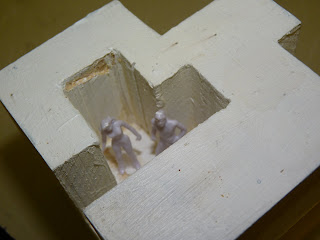Free for All (Part 1) showcased the best of the festival’s open submissions. The varied and eclectic works were pieced carefully together by curator Emily Songhurst, comprising an Aladdin’s Cave of viewing. There was video installation, painted portrait, photography, sculpture, interactive sound-art. And all in one barren, concrete vacuum; divided into a complex of almost-rooms, maze-like that encaved the works and created a semi-private capsule for each artist. There were nooks to be discovered, perfect for the deeply personal pieces that were on display. If there was an overarching theme this was it – soul-bearing. Some of it was confusing, some of it bad (in my opinion) and some of it funny – which is rare. I craned to read the small print of a ‘sculpture’s title – the miniature pram with tubes coming out of it feeding into big bourbon bottles – ‘Wet Nurse’, and laughed. Apart from small titles, the smallest photographs overtook the whole rest of the show. Ines Elsa Delal’s photographs: personal, beautiful, and almost missable – the man handing us our beers hit it in one – ‘they got me’.
We had heard tell of the polystyrene balls before we entered room 2. But fortunately the anticipation did not breed disappoint when we finally peeled back the curtains on Child’s Play and skated off in our polythene shoes, tiny, packaging filler balls underfeet. I laughed for the second time, and raced off like a kid in a candy shop. That is, until I ran into the sweet shop installation which presented a disconcerting choice: to take a sweet out of the jar or not. What kind of person am I that I didn’t take a sweet? I think it says more about what kind of child I was, but that child is clearly still master puppeteer of at least some of my actions. From exciting, to contemplative this room threw up a whole load of sweet nuggets for the audience to chew over whilst moonwalking on polyballs. The tone of the exhibition was reset when the monkey-bar on tree trunks installation in the centre of the room, a piece by Sonny J. Barker entitled Gemini, was explained to us. It charted the death of the artist’s twin in his childhood, and just like that the fantasy of being a child splintered away from us. So much of childhood is about loss. And childhood in hindsight can often be seen only in negatives; landmarks thrown into relief by the pain they caused. But childhood is really the least of the issues facing you in Child’s Play. The use of a theme is a jumping off point for exploring how different artists, and therefore different people, interpret the same thing. And this itself is a jumping-off plank for how art documents the human experience. Is art itself child’s play? And if so does the exhibition subvert or add to this notion of art? Like most ‘good’ art, the room created more questions than it answered. And, much like childhood, the more I reflect on Child’s Play, the more disturbing it appears to be.
A wise man once said that art ‘is supposed to make us confront things’. And a lot of the stuff that needs confronting isn’t palatable, or fun to look at it. Some of it is. The Piccadilly Place free for all presented us with a wide scope of reality, as much of it from the art as from the people looking at the art. We were bumped up cheek to wall with people of all brush-strokes and veins of art but the thing we really looked at was ourselves.
=====================================
This was the review of the show that I was involved in for the Free For Arts Festival 2011..the reporter/reviewer was Phoebe Chambre.















